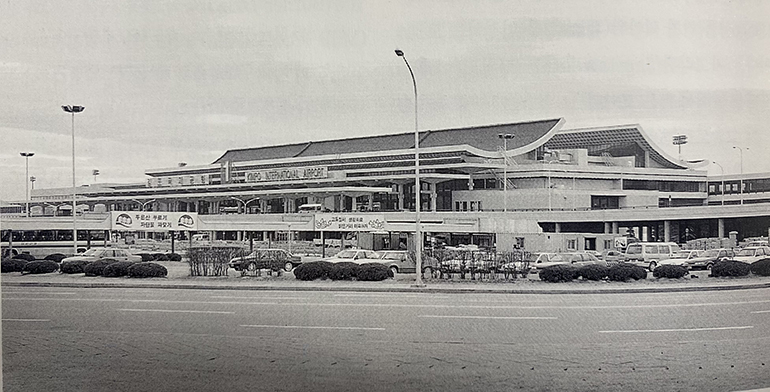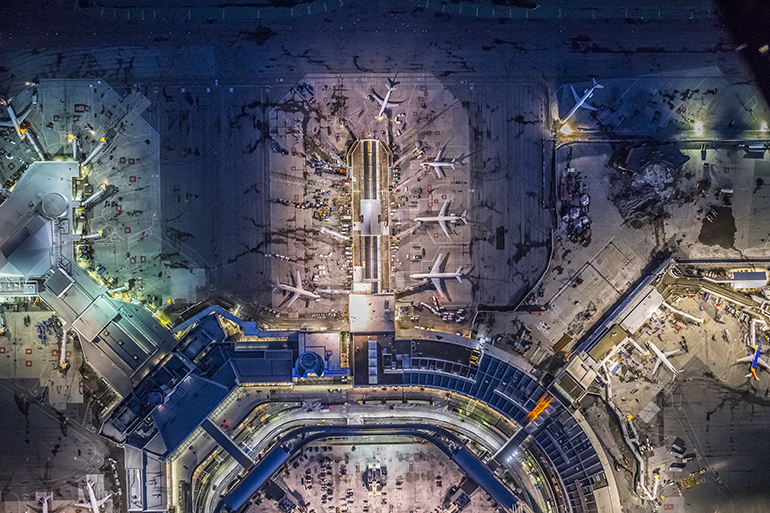
Latest News
- Hyundai E&C Accelerates Global Nuclear Expansion into the U.S. Nuclear Market
- Hyundai E&C Shifts into High Gear to Enter Nordic Large-Scale Nuclear Market
- Hyundai E&C Strengthens Korea-Japan Cooperation in Energy Transition and New Growth Businesses
- Hyundai E&C Signals Green Light for Large-Scale Nuclear Power Plant Business in Europe
- Hyundai E&C Unveils Energy-driven Growth Strategy “H-Road”
Secrets of Airports Shared by Hyundai E&C`s Airport Experts

An airport is the first thing you encounter when you travel abroad. Many people may believe that the passenger terminal is all there is to an airport, but it's only a small part of the picture. Here are our airport experts at Hyundai E&C who will explain about all the exciting stories behind airports.
Written by Lee Hee-jung / Assisted by Park Seong-won, Senior Researcher (Hyundai E&C Enabling Technology Lab)
Birth of airport...A to Z of airport construction in history
The world's first airport was “College Park Airport” in Maryland, built by the Wright brothers in 1909. At the time, it was built for US Air Force officers for their flight training. Airports similar to the current form appeared after World War II with the development of aircrafts. The first airport in Korea was “Yeouido Airport (1953)”, which had been used as a training center and air base since the Japanese occupation. At the time, the runway of the Yeouido Airport was frequently flooded by the Han River, and the airport facilities were also poor. To address these fundamental problems, the government opened Korea's second airport, “Gimpo International Airport”, in 1958. Initially, Gimpo International Airport saw almost zero demand for a while, but after the economic development in the 1970s and the decision to liberalize overseas travel in 1989, the number of passengers surged. During this period, Hyundai E&C also participated in 27 construction projects, including the expansion of the runway and the construction of a new passenger terminal at Gimpo International Airport.

[A view of the Gimpo International Airport building in July 1980. Hyundai E&C participated in 27 airport construction projects from 1969, when it took part in the first expansion of Gimpo International Airport, until 1980]
Around the world, airports have traditionally been built on land around urban centers. However, with the growth of cities, development has gradually expanded to include areas around airports, and with the concentration of population, it has become increasingly difficult to expand and build new airports in urban centers due to rising real estate prices and aircraft noise concerns. Therefore, in recent years, airports have mainly been built on reclaimed land near the sea. Coastal airports are advantageous in terms of aircraft noise environmental regulations, making it relatively easy to operate at all hours of the day and expand airport facilities, as well as reducing damages in the event of an engine failure during takeoff or landing compared to inland airports. The development of reclamation technology using caissons is also driving the construction of maritime airports, and "Ulleung Airport", which is currently under construction, is the first maritime airport in Korea to apply the caisson method.
Ever since 1903, when the Wright brothers took to the skies for the first time, airplanes have become a universal mode of transportation. We are now in the midst of an “aviation renaissance". and people naturally think of airplanes when they want to travel long distances. In line with this trend, Korea has launched a number of airport construction plans, including building of small airports such as Heuksan and Baekryeong airports, as well as Saemangeum International Airport and Gadeokdo New Airport. Building an airport requires a lot of resources, a large site, and a long construction time, which means that many factors need to be considered from the initial planning stage. A pre-feasibility study should be conducted to examine the demand for air travel in the local area, as well as the surrounding land use plan, policy direction, traffic conditions, and natural environments such as migratory birds, typhoons, tsunamis, and earthquakes. In order to select a site for an airport, it is fundamental to visit many different sites and analyze the terrain, wind direction, weather, and residential conditions of each site. Once the basic plan is finalized following this process, we move on to the basic and implementation design stage, where the actual construction company can carry out the construction. Accidents at airport can result in a great loss of life, so it is important to design and build with an ultimate focus on the safety of aircraft operations.
Everything you need to know about designing a state-of-the-art airport
An airport consists of a variety of facilities, including the familiar passenger terminal, cargo terminal, runways, moorings, taxiways, etc. All of these facilities are designed and laid out in a very scientific and systematic way. Among them, the runway, the road that the wheels of an airplane will contact when taking off or landing, is crucial.

○ Global warming-runway nexus
The most important condition when planning a runway is the wind direction. This is because aircrafts use the wind to take off and land. If you look at the orientation of the runway, you can tell which direction the wind is blowing in the area. Temperature and altitude also have a big impact on runway length. Experts have found that for every 3°C increase in temperature, lift force that keeps an airplane aloft decreases by 1%. As temperature and altitude increase, pressure and density decrease, which in turn reduces engine power and lift. Therefore, runways need to be lengthened by 1% for every 1°C increase in temperature in order to provide enough thrust for an aircraft engine.
If global warming continues, studies show that after 2050, airplanes taking off during the hottest hours of the day will need to reduce their takeoff weight (TOW) by 0.5% to 4% to use existing runways. Reducing takeoff weight also means reducing payload and fuel, making it more difficult to secure long-haul routes. This can affect the airline operator's bottom line, so it is important to ensure that runway lengths are sufficient to account for airport temperatures when planning airports.
○ Special runway pavement
From a distance, runways look like any other roadway, covered in concrete and asphalt, but they have a special pavement design and construction. To withstand the load of an aircraft weighing the equivalent of 25 25-ton dump trucks landing at speeds around 200 kilometers per hour, the pavement thickness of runways is nearly 1 meter thick, which is two to three times thicker than that of regular highway. In addition to bearing the load, it is also important to keep the runway surface smooth for safety, and unlike regular roads, cracks in the seams of runways can lead to major accidents, creating the need for special paving techniques. In recent years, a “wide formation paving method” has been used, which is inspired by the flight formation of aircrafts and involves the use of multiple paving equipment at once. This allows for a smooth pavement with no seams, improving the quality of the pavement and the reliability of airport operations.
○ Advanced air navigation system capable of landing in fog
Air navigation systems are constantly evolving to provide safe travel for visitors. “Navigation safety facilities” are systems to ensure safety during takeoff and landing of aircraft. Navigational safety facilities are divided into two types: aviation lighting facilities, which provide visual information to pilots, and navigational safety radios, which provide information to airplanes via radio waves. Aviation lighting facilities provide pilots with visual information about the runway location using lights, just as lighthouses at sea provide navigation guidance, and there are more than 30,000 lights at Incheon International Airport that serve as pilots' eyes.
“Navigation safety radio” is a device installed on the runway that emits radio waves to airplanes and displays the angle and distance of the landing on the instrument panel. In recent years, satellite navigation systems such as GPS have made it possible for airplanes to fly autonomously using so-called “autopilots,” which provide accurate routes. This makes it possible to take off and land safely even when visibility is poor due to fog or heavy rain.
“K-Construction” kick starts overseas airport projects··· Hyundai E&C to build “Chinchero New Airport in Peru”

[Aerial view of the new airport in Chinchero, Peru (left) and the actual construction site (right). Civil works to develop the airport site began in April 2021 and completion is scheduled for July 2023, while construction of the runway and passenger terminal is underway to be finalized in August 2025]
Airport development is one of the world's top three infrastructure markets after railroads and roads. Experts predict that the scale of airport investment will increase significantly in the Covid-19 endemic era. In fact, a number of overseas bids have been announced recently, including a new airport plans in Poland and Long Thanh Airport in Vietnam.
Here is a project that marked the beginning of overseas airport development projects that K-Construction is pursuing. It is the “Peru Chinchero New Airport” project, which Hyundai E&C is in charge of constructing. The Ministry of Land, Infrastructure, and Transport and Korea Airports Corporation formed “Team Korea” to enter the South American airport market for the first time in the form of a government-to-government (G2G) contract between Korea and Peru. Team Korea is responsible for PMO (Project Management Office), which involves managing the entire project, including design review, construction process, and commissioning, on behalf of the Peruvian government, and Hyundai E&C is in charge of the construction, which is particularly meaningful. In 2021, when the covid-19 pandemic was at its peak, Hyundai E&C won consecutive orders for site preparation work and the main construction of the passenger terminal, with a total project cost valued at KRW 760 billion, and is currently successfully administering the project by heading a joint venture consisting of global companies from Mexico, China, and Peru.
The Chinchero New Airport is the gateway to the world-famous Inca heritage site of Machu Picchu, with a capacity of 5.7 million passengers per year. It has one 4-kilometer runway, a terminal (52,300 ㎡) with 13 boarding bridges, and a mooring area (90,000㎡). The area is subject to extreme weather conditions throughout the year, and it rains almost every day from December to March, which is the local summer season. Moreover, it is located at an altitude of 3720 meters above sea level, making the working environment challenging to that point that, first-time visitors must take mountain sickness medications. Hyundai E&C will use advanced equipment to ensure construction quality and air quality compliance, and a large-scale workforce of up to 1,200 people per day to complete the preparation of the airport site in July, achieving another important milestone in the construction process. The subsequent constructions of the runway and passenger terminal are on track for completion in August 2025.
The same scientific approach to airport design mentioned about can be also observed at the new Chinchero Airport. Because of its high-altitude location, the runway has been designed to be 4 km long* with no aircraft size or weight limitations, despite the fact that the main operating aircrafts are small. For large aircraft such as Airbus A350, the maximum takeoff weight is limited to 85% to ensure safety. In addition, various advanced construction technologies such as drone surveying, BIM modeling, AMG (Automated Machine Guidance)*, and FMS (Fleet Management System)* are being applied to ensure smart and safe construction. In addition, Hyundai E&C's pavement technology experts are actively using the U.S. Federal Aviation Administration's (FAA) FARFIELD system to review the appropriateness of the runway pavement cross-section, and the site plans to simultaneously deploy multiple asphalt pavers for runway construction to improve the quality and durability of the runway and shorten the construction time.
*Typically, a runway length of 4 kilometers allows large aircraft such as Airbus A380 and Boeing B777 to operate without weight restrictions. Large hub airports such as Incheon International Airport and Singapore Changi Airport have runways that extend to 4 kilometers.
*Automated Machine Guidance (AMG): This is a technology that assists in earthmoving, and at the site of the new airport in Chinchero, it is being used on backhoe shovels, dozers, and graders. In the case of the backhoe shovel, 3D drawings are entered and displayed on the driver's screen to assist the driver's operations, and in the case of the dozer and grader, the blades of the equipment are controlled semi-automatically to improve the accuracy of the work.
*FMS (Fleet Management System): This is a technology that collects data by installing GPS on vehicles. At the Chinchero New Airport site, the technology is being applied to dump trucks to analyze operational data such as daily distance traveled.

[Singapore Changi Airport (left) and Incheon International Airport's Terminal 2 (right) built by Hyundai E&C]
As mentioned above, airports carry a large number of travelers and cargo, so it is important to build them safely by integrating the know-how coming from different types of construction, such as civil engineering, architecture, and plants. Unlike general construction, airports are built according to international standards of the International Civil Aviation Organization (ICAO)*, the U.S. Federal Aviation Administration (FAA)*, and the International Air Transport Association (IATA)*, thereby requiring high level of technical skills and construction capabilities. With its proven portfolio of projects including Gimpo International Airport, Incheon International Airport, and Singapore Changi Airport, Hyundai E&C is broadening its reach into the global market with its advanced technology. We look forward to your continued support for Hyundai E&C, which has embarked on its exciting journey to raise the status of K-Construction by opening up the skyways of the world across land and sea.
*International Civil Aviation Organization (ICAO): A specialized United Nations agency established in April 1947 based on the International Civil Aviation Treaty, with the goals of ensuring the safety of flight, promoting the development of airways and airports and aviation facilities, and preventing economic losses due to unfair competition.
*Federal Aviation Administration (FAA): A subdivision of the U.S. Department of Transportation responsible for maintaining the safety of air transportation. Aircraft cannot be developed, manufactured, repaired, or licensed to operate in the U.S. without its approval, and most airlines must follow FAA regulations to operate as passenger carriers.
*International Air Transport Association (IATA): A private organization representing 239 airlines from 131 countries around the world, often referred to as the "United Nations of the airline industry". IATA represents airliners on issues related to international airfares, flight schedules at major international airports, and airport facility charges.

